|
|
|
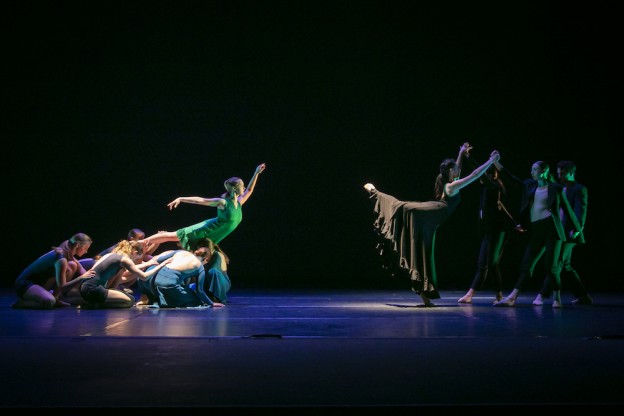
|
|
|
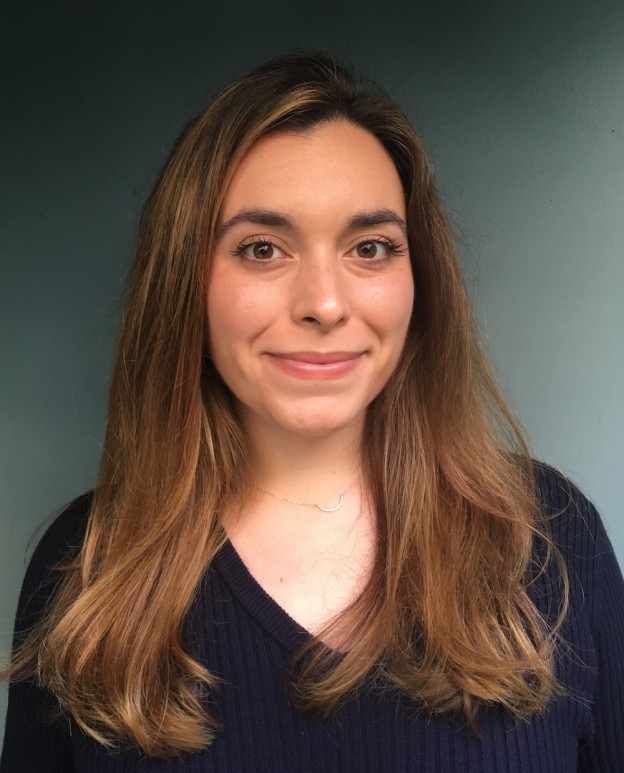
On April 8th, Megan Race, a postdoctoral fellow at Harvard’s Davis Center for Russian and Eurasian Studies, came to speak to Swarthmore students and faculty in a lecture on George Balanchine’s 1962 tour of the Soviet Union. Combining her academic research in Slavic Languages and Literatures with a long-established love for dance, Race has been working on a project that explores the Soviet media reception and depiction of the New York City Ballet. And throughout her lecture, she focused particularly on how Balanchine’s “modernist” ballets were received in the Soviet Union, a place where the government had laid out socialist realism expectations for the arts since the 1930s.
Professor Olivia Sabee of the Swarthmore Dance Program first met Megan Race when both were completing their undergraduate degrees at the University of Chicago.
“I met Megan about fifteen years ago when we danced in a production of Le Corsaire together. Though we didn’t know it at the time, those experiences staging (we both also set portions of this ballet and Cinderella on other dancers) would be formative in realizing how work in the studio might intersect with academic research,” Sabee reminisced.
A few years ago, Race’s and Sabee’s paths crossed again when they met at the American Comparative Literature Association conference. At the time, Race was working on her current project researching George Balanchine and Russian emigré culture, and since then, the two scholars have kept in touch, leading to Sabee’s invitation for Race to present at Swarthmore this spring.
Drawing on her past and concurrent research on Vladimir Nabokov and cultural politics of the Cold War, Race placed Balanchine’s 1962 tour of New York City Ballet in the Soviet Union within the context of the Kruschev Thaw. By analyzing Balanchine’s choreography as a whole, as well as providing the history of the balletEpisodes – whose original version, which also included choreography by Martha Graham, is no longer performed – Race drew attention to the inextricable relationship between dance and the wider cultural and historical connotations.
Sabee further elaborated on how Race’s lecture and research, in addition to having Soviet era implications, can be viewed within the lens of contemporary Russia-U.S. relations:
“Megan’s research is distinguished in part by her ability to draw on her Russian skills to show us a different picture of Balanchine and his reception…[And] through her work on Vladimir Nabokov…[she] shows how Balanchine was part of a larger Russian emigré culture. By examining Balanchine’s work with a wider lens, her work has the potential to connect the history of theatrical dance with a broader picture of what is going on in America and in Soviet-American relations at this time.”
Lectures like Race’s and opportunities to engage in deep academic discussion of the arts distinguish the Swarthmore Music and Dance Programs. From performance opportunities, to exposure to rigorous academic research, classroom and lecture hall, to the studio, students have the possibility to deepen their love for the arts.
Marion Kudla ’19
On April 6th and 7th, Swarthmore College hosted the 2019 Mid-Atlantic Chapter of the Society for Ethnomusicology (MACSEM) conference. MACSEM, established in 1981, is one of ten regional chapters of the Society for Ethnomusicology (SEM). Founded in 1951, SEM promotes the research, study, and performance of music in its cultural, social, and political contexts. Each chapter of SEM holds a conference in their respective regions, providing an opportunity for students and ethnomusicologists to share current research. “Because of the smaller nature of the regional chapters it is also a wonderful opportunity to network and get to know other people in the area,” Professor Lei Ouyang Bryant said.
Professor Lei Ouyang Bryant, from the Department of Music and Dance, had several reasons why she wanted Swarthmore College to host this year’s MACSEM conference. The first was to help with the integration of more ethnomusicology into the Department of Music and Dance. Professor Bryant has been offering courses in ethnomusicology regularly, including a seminar on ethnomusicology this semester. “We planned for the seminar and conference to be held in the same semester so my students could help with the planning, hosting, and participation in the conference,” Professor Bryant said. “It was a unique opportunity for students to engage with graduate students, professionals, and faculty from other institutions, who are all working in various aspects of ethnomusicology.” Second, hosting the conference at Swarthmore College gave Professor Bryant the opportunity to work closely with outgoing President of MACSEM and Swarthmore alumna Shalini Ayyagari ‘00. “She was excited to return to campus for this year’s meeting and to work together on the conference planning,” Professor Bryant said. Lastly, hosting the conference at Swarthmore was a good way to bring together local ethnomusicologists from University of Pennsylvania, Temple University, and the general region.
This conference’s keynote speaker was Professor Karen Shimakawa (pictured above) from New York University. Her lecture, titled “Catastrophic Sounds: Animacy and Equivalence,” examines the work of performance/video artist Eiko Otake, in her “A Body in Places” series, to consider how it situates viewers in time and space (aural and architectural) in order to make the catastrophe of capitalism perceptible.
Professor Bryant pointed out that in recent years, MACSEM invited speakers who were related, but not directly centered within the field of ethnomusicology. “Professor Shimakawa was invited to present this year’s keynote lecture because of her research and teaching interests in performance studies and Asian American performance, critical race theory, law and performance,” Professor Bryant said. “Her areas of expertise all provide engaged connections to/with ethnomusicology while also speaking to Swarthmore student interests.”
MACSEM was not only a space to share individual research; the conference allowed Swarthmore students to showcase their musical talents and abilities. Two pop-up concerts were held, featuring the Chinese Music Ensemble and the Taiko Ensemble.
Overall, Swarthmore’s hosting of this year’s MACSEM conference was a success, in terms of bringing together local scholars with a diverse range of interests within the field of ethnomusicology. Professor Bryant expressed great pleasure for her colleagues and her students who helped organize and plan the conference because she could not have succeeded without their generous support. “It was a really rare opportunity to have such a broad range of research presentations right here on campus for students to attend and ask questions. I was incredibly proud of their thoughtful questions and for the many engaged conversations they had with visiting ethnomusicologists,” Professor Bryant concluded.
David Chan ’19
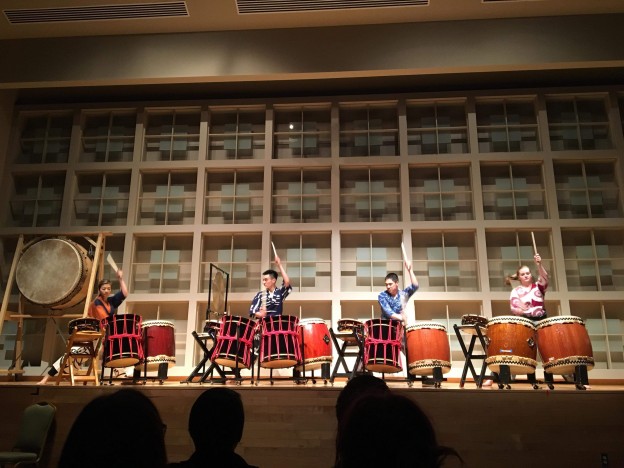
“Growing Stronger” was the theme of this year’s East Coast Taiko Conference (ECTC), which was held at Cornell University from February 22nd to 24th. ECTC chose that theme with the hope to enrich participants’ knowledge of taiko and its community through the opportunity to learn the roots of various taiko styles, to strategize ways to improve group performances, and to build community. This conference has occurred annually since 2011, and this year’s conference saw an attendance reach up to about 200 taiko practitioners (collegiate, amateur, and professional).
A contingent of Swarthmore students from the Taiko Repertory class attended this conference, led by Professor Joe Small. These students are Josie Hung ’19, Hunter Lee ’19, Haruka Ono ’19, Shuang Guan ’19, Kira Emmons ’20, Faye Ma ’20, and Jason Wong ’21. This was the first ECTC for Swarthmore students and Professor Small could not have been more excited to bring his students to this year’s gathering. “I am overjoyed that Swarthmore students made the trip and got involved,” Small said. “Certainly one learns a lot from both theory and practice, but taking part in the community is a whole different way of understanding one’s self while learning about the art.”
Guan can attest to Professor Small’s sentiment that participating within a wider community of taiko practitioners is a very different way to practice and to learn taiko. “At Swarthmore, we learn taiko through preparing for one performance piece for the spring concert,” Guan said. “We don’t really get time to talk about the complexity and diversity of taiko, like its sociocultural/political importance, and what doing taiko looks like outside of Swarthmore. ECTC helped to expose me to some of its multitudes, whether that was the different instruments and playing styles of taiko, the different structures and purposes of other taiko groups, or the diverse peoples that are part of taiko.”
At the final concert of the conference, Professor Small, his colleague Isaku Kageyama, Hung, Emmons, and Wong all performed Small’s original composition called “Propel” as the opening performance. The piece is demanding, requiring stamina and technique, but Professor Small is proud of his three students who were able to excel under the pressure. “The audience’s response was an immediate and thunderous standing ovation,” Small said. “The best remark I heard was that it didn’t seem like ‘three students being pulled along by two professionals,’ but a performance where they carried their own weight and that of others.”
Hung felt deeply honored to have shared the stage with such talented and wonderful people, and she was surprised by the audience’s reception. “I did not expect that an opening performance could get a standing ovation,” Hung said. “But it was extremely rewarding getting a standing ovation as the first act of the night and then having various people come speak to us afterwards about being blown away and really enjoying it.”
All of the Swarthmore student attendees found that ECTC generated discussions among themselves about taiko’s relationship to Asian America. “The conference started some discussions among us Swatties about the nuanced ways taiko interacts with identity formation and empowerment, especially within Asian-America, and we’ve continued to have those discussions back at Swat,” Guan said.
At the same time, ECTC was critiqued for not addressing certain issues. “At ECTC, I found myself debating whether or not there should have been more room for critical conversations of taiko, positionality, and identity within the short span of the weekend,” Hung said. “The question is, considering the dynamics and demographics of the Asian American community now and the need to challenge the centralization of East Asians in conversations of Asian American identity and issues, can the taiko community be more inclusive to the wider Asian American community, and if so how?” Hung further extends this question to ask whether taiko can also be inclusive of non-Asian people of color.
Overall, ECTC has been an eye-opening experience for the Swarthmore students in attendance, with some of the seniors now contemplating joining a taiko group after graduation. The conversations about taiko’s relation to race, class, gender, and colonial history still continue today for these students back on campus, especially since Professor Lei Ouyang Bryant offers a seminar called “Taiko and the Asian American Experience.” In that class, students have an opportunity to develop a greater understanding of taiko within historical, cultural, and artistic contexts. Professor Small hopes that attending ECTC will become an annual tradition for Swarthmore students, and that they continue to take part in the greater taiko community even after college.
David Chan ’19
Before Moses Rubin ‘19 even arrived at Swarthmore as a freshman, they had the love and passion for music instilled within them. Rubin took their opportunity as a child of a musician living in New York City to explore and learn how to play different genres of music. When Rubin began taking guitar lessons at age seven, they became inspired by singer/songwriters like Johnny Cash and Bob Dylan. As they grew older, they explored punk and jazz music, admiring artists like Stevie Wonder, Marvin Gaye, and James Brown. During their high school years, Rubin took their musical exploration even further and went out multiple times to various venues in New York City where live music was playing. They recall visiting “a bunch of jazz clubs and bars when [they were] in high school,” and they soon realized that no matter what they did with their life, they “needed to be around [music] all the time.”
Upon arriving at Swarthmore, Rubin didn’t originally intend on studying music in an academic setting, however, they still found a way to keep their passion for music alive by joining Caboose, a band which still actively performs today. Their involvement with Caboose helped fill the “artistic vacuum” Rubin said they felt during that time of their life. Caboose gave Rubin a community to belong to. Though Rubin writes their own songs and at times enjoys music on their own, being a part of Caboose helped them realize that they were their “happiest when [they] were playing with other people”.
As they started to invest more dedication to Caboose and their individual musical pursuits, Rubin decided to study music academically to improve their musical skills. However, what Rubin values most from their music classes is not so much rooted in academics but more in the “spiritual” experience of music. Rubin learned through their classes to “think critically about music,” to appreciate its history and current stature while at the same time being able to criticize its limitations. According to Rubin, space is one realm of music that they “never really understood before Swarthmore.” Rubin sees Swarthmore as “a reflective and thoughtful place”, especially when it comes to the idea of taking up space though presence or expression, and “the most important skill” the music program has taught Rubin is to listen to the space they are taking up as an artist. By listening and engaging with the space that both the audience and performers are simultaneously altering, Rubin says “it becomes a shared experience,” and though Rubin has been around music their whole life, Rubin recognizes this “shared experience” of music as something “unique to Swat.”
Though many experiences Rubin has had with music are unique to Swat, they still plan to take all they have learned and apply it to their life after graduation. This summer, they will use their background in production by working as a sound designer for a dance company. In addition, they and another musician are working on an application to the Fringe Festival in Philadelphia. When Rubin graduates this spring, they will leave Swarthmore “very excited to start [their] own musical projects.”
Maria Consuelo de Dios ’21
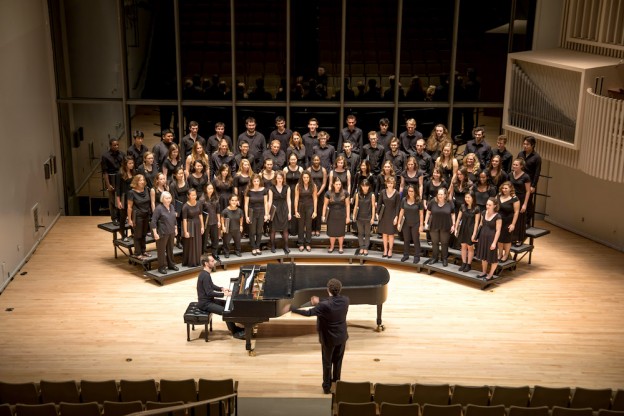
On Friday evening at 8:00 in Lang Concert Hall, the Swarthmore College Garnet Singers and the Swarthmore College Chorus will present their spring concert under the direction of Joseph Gregorio and alongside featured guest ensemble Variant 6.
This concert will cap off Variant 6’s yearlong term as Featured Guest Artists, which included a masterclass with the Garnet Singers, a masterclass for solo singers, and several reading sessions for new works by student composers. “Variant 6 has contributed a great deal to the education of singers and composers in our Department this year,” says Professor Gregorio. “Singing alongside and getting helpful feedback from such highly polished and professional musicians elevated the level of music-making among our singers, and hearing Variant 6 read student compositions was an invaluable opportunity for student composers to learn about writing for voices.”
On the first half of Friday’s concert, the Garnet Singers will be joined by Variant 6 for their entire set, which comprises music composed by Sulpitia Cesis, John Wilbye, Francis Poulenc, David Conte, Lili Tobias ’19, and Benjamin Britten. All of the Garnet Singers’ pieces are connected in some way to the theme of plants, according to Gregorio. “I’ll admit that it’s a bit of a strange theme,” he says, “yet each of these pieces met the group at the right level and helped us grow as an ensemble.”
Variant 6 will perform an excerpt of Caroline Shaw’s To The Hands to conclude the concert’s first half.
The Chorus, accompanied by an orchestra of strings, brass, and chamber organ, will perform a set of polychoral music on the second half of the concert. Once again, in various roles determined by the needs of the music, Variant 6 will take part. “Polychoral music comes in many varieties,” explains Gregorio. “Much music for multiple choirs is written in eight parts, for two roughly equal choirs. However, music for three or more choirs also exists, as does music written for two unequal choirs. Chorus will be lucky to have Variant 6 helping us bring this music to life in several ways — for example, Britten’s A Hymn to the Virgin (which he wrote when he was only sixteen years old!) asks that Choir II be sung by a semi-chorus or solo quartet. Variant 6 will serve as this small ensemble, while Chorus serves as Choir I. In Jacobus Handl’s Alleluia, cantate Domino canticum novum, which is scored for three choirs, Variant 6 will serve as one of the choirs, and Chorus, split in half, will serve as the other two. And in the other works Chorus is singing, which are scored for two equal choirs, Variant 6 will sing spread out among the members of the Chorus, as they will have done on the first half with Garnet Singers.”
Several facets of this semester’s choral concert stand out as unusual. “Aside from the remarkable and unique opportunity our singers will have to perform alongside Variant 6, the concert will feature two particularly noteworthy contributions from students,” Gregorio says. “For Wilbye’s madrigal Flora gave me fairest flowers, the combined forces of the Garnet Singers and Variant 6 will be led by assistant conductor and bass section leader Deondre Jordan ’19, who has rehearsed the piece all semester with the singers and shaped a beautiful interpretation of it. The Garnet Singers and pianist Mia Shoquist ’21 are also very proud to present the premiere of Herbae Ignotae (Unknown Plants), a piece by Lili Tobias ’19 that sets the names of plants in a language constructed by Hildegard of Bingen. I’m quite glad this concert features Deondre’s and Lili’s work so prominently; they have been stalwart members of both choral ensembles during their time at Swarthmore, and both groups and I will miss them dearly when they graduate. We’ll also be saying goodbye to soprano and tenor section leaders Rebecca Regan ’19 and Ben Warren ’19, who have likewise contributed immensely to Chorus and Garnet Singers.”
Desta Pulley ’17
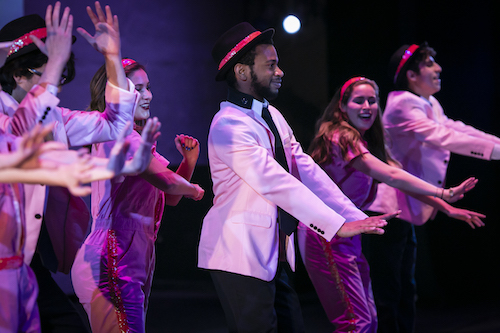
The semesterly Dance Concerts are opportunities for students participating in Swarthmore’s Dance Program to showcase the work they have been doing over the past semester. This spring’s show will feature ballet, tap, African, and taiko, as well as student-choreographed pieces. Students from all levels and backgrounds of dance participate, forming a collection of individual pieces that, together, reveal the depth and dynamism of Swarthmore dance.
Professor Chandra Moss-Thorne will be showing her newest piece, Plight, at this year’s event. Featuring more than 20 dancers, this contemporary ballet work is set to the music of Italian composer Ludovico Einaudi. Professor LaDeva Davis’s tap dancers will be dancing to music by Aretha Franklin in a piece called Think. The lyrics of the song were written by Ira Tucker Jr. to “accommodate a public service campaign” about the “dangers of driving under the influence.” Professor Saleana Pettaway’s MISS Understandings is set to the music of Rick Allen, Beyonce, the Ibiza Royal Drums, and Me’Shell Ndegeochello. The work is a “tribute to the female experience…It celebrates the power of the female collective and the beauty of our diversity.” Finally, Professor Joe Small’s taiko drummers and dancers will perform a set of arrangements from Japan and beyond. While Soma Bon Uta is a “popular standard at obon across Japan and overseas,” the employment of the ukulele “pays homage to the connection between Japan, Portugal, and Hawaii.” Additionally, Kris Bergstrom’s Jack Bazaar showcases “not the iki of Edo, but Los Angeles.”
The Spring Dance Concert will also feature student works from Zara Williams-Nicholas ’19, Lia D’Alessandro ’21, and Marion Kudla ’19. These pieces allow student choreographers to demonstrate both their technical abilities and their skills in visual composition. Zara Williams-Nicholas’s original work titled Weeping Blue Mahoe, is a piece about identity formation and the “exploration of the self in relation to others.” More than that, Williams-Nicholas says that her dance is reflective of her own experiences here at Swarthmore: In some sense, this work is an “autobiography of [her] journey of finding [herself] at a predominantly white institution.”
Lia D’Alessandro’s piece, Progression, is a contemporary ballet work about the “escape from the traditional image of females in ballet as delicate and dependent upon men.” D’Alessandro says it was inspired by her journey as a ballet dancer “who does not fit the stereotype. It showcases the strength and athleticism of a female dancer in the 21st century.”
Marion Kudla will be presenting her piece titled, Into Interior. Kudla says the work is an extension of a piece she choreographed last fall, called Imprints, which explored the biological concept of rewilding. Rewilding is “an environmental conservation tool that reintroduces ‘native’ species into an environment and lets nature take over to return to an ‘original’ state. Her new piece takes this idea and uses it to explore nature as an “emotional, psychological space.” A work of contemporary ballet, Into Interior “plays on the duality of the word ‘interior’ as both a signifier for nature as well as a personal, reflective process.”
The Spring Dance Concert allows everyone to participate in the incredible diversity of Swarthmore’s performing arts. Faculty works are shown alongside student pieces, and radically different styles occupy the same space. Swarthmore’s dance concerts are a chance for members of the community to experience the hard work of students and faculty, who together reveal the unique kind of joy and catharsis that dance can provide.
The Spring Dance Concert will be held on Friday, May 3rd at 4:30 PM, and Saturday, May 4th at 8:00 PM in the Lang Performing Arts Center. The event is free and open to the public.
Gabriel Hearn-Desautels ’20